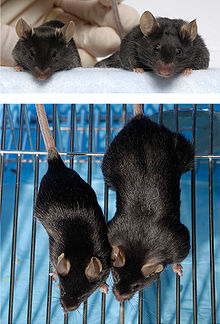Gene knockout
Under gene knockout complete shutdown is ( Engl. Knock-out = "put out of action") of a gene in the genome of an organism understood. Shutting down the gene is achieved through gene targeting . In animals, the embryonic stem cells are manipulated and introduced into the germ line of an individual. These are further bred to create an animal whose cells all contain the gene that has been switched off. In plants, only gene targeting has been established in Physcomitrella so far . Here protoplasts are transfected with the knockout construct and regenerated directly into moss plants ( protonemes ). As early as eight weeks after transfection , the plants can be checked for gene targeting using the polymerase chain reaction (PCR) .
Organisms that have been manipulated accordingly are called knockout organisms . If two genes are switched off at the same time, one speaks of a double knockout (DKO) and with three genes of a triple knockout (TKO).
application
Organisms with switched off genes are now indispensable model organisms in many areas , with which the most diverse research and development projects are carried out. In basic research, switching off certain genes is used to draw conclusions about the function and mode of operation of the gene. Many genes are also conserved in humans , so that the results can very often be transferred directly to humans. A number of human hereditary diseases that are caused by genetic defects can be better researched in such organisms. The development of active ingredients for the therapy of the corresponding diseases is considerably facilitated by these model organisms.
In 2007 the Nobel Prize in Physiology or Medicine was awarded to Martin Evans , Mario Capecchi, and Oliver Smithies for their work on knockout mice.
differentiation
With gene knockout, the affected gene is completely switched off. With knockin , on the other hand, a specific gene modification is carried out in which an additional gene or a desired DNA sequence is inserted at a defined point in the genome of the model organism. The gene knockdown describes a partial shutdown of the function of the gene.
further reading
- Reference books
- TW Mak: The Gene Knockout Factsbook. Academic Press, 1998, ISBN 0-12-466044-4 .
- R. Kühn and W. Wurst: Gene knockout protocols. Humana Press, 2009, ISBN 1-93-411526-6 .
- Review article
- A. Bartke: New findings in transgenic, gene knockout and mutant mice. In: Exp Gerontol 41, 2006, pp. 1217-1219. PMID 17049788
- S. Tonegawa et al .: The gene knockout technology for the analysis of learning and memory, and neural development. In: Prog Brain Res 105, 1995, pp. 3-14. PMID 7568891
- HC Tai et al: Progress in xenotransplantation following the introduction of gene-knockout technology. In: Transpl Int 20, 2007, pp. 107-117. PMID 17239018
Individual evidence
- ^ R. Reski : Physcomitrella and Arabidopsis: the David and Goliath of reverse genetics . In: Trends Plant Sci . 3, 1998, pp. 209-210. doi : 10.1016 / S1360-1385 (98) 01257-6 .
- ↑ A. Hohe, T. Egener, JM Lucht, H. Holtorf, C. Reinhard, G. Schween and R. Reski : An improved and highly standardized transformation procedure allows efficient production of single and multiple targeted gene-knockouts in a moss, Physcomitrella patens. In: Current Genetics. 44, 2004, pp. 339-347. doi : 10.1007 / s00294-003-0458-4 .
- ↑ J. Osterkamp: Cooperative Exactly case incidence. In: Spektrumdirekt from October 9, 2007.
- ↑ Information from the Nobel Foundation on the 2007 award ceremony for Martin Evans, Mario Capecchi and Oliver Smithies (English).

